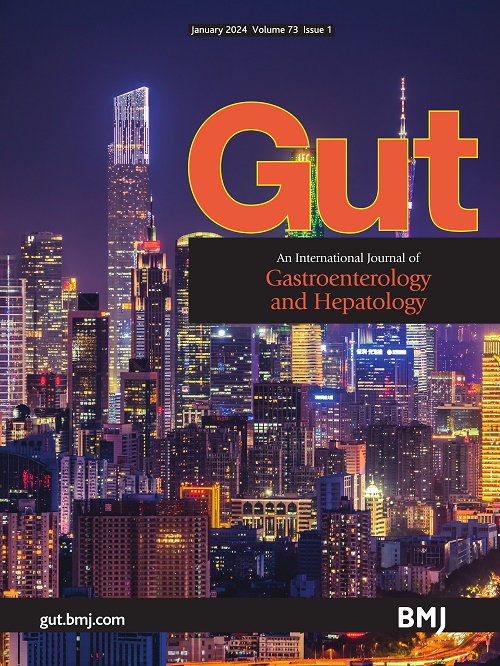Biology of regional gut-mucosal-transcriptomes in healthy individuals and individuals with diabetic: incorporating cellular composition and embracing variation
IF 25.8
1区 医学
Q1 GASTROENTEROLOGY & HEPATOLOGY
引用次数: 0
Abstract
Hannah Gilliam-Vigh and coworkers1 highlight that regional transcriptome differences are much larger than the difference between healthy and diseased individuals. Moreover, a substantially larger degree of regional difference was observed in the small intestine compared to the large intestine, inspiring separate intraregional transcriptome analyses for the small and large intestinal samples to enhance the resolution of detection of differentially expressed genes (DEG) in the large intestine. Clustering of regional transcription landscapes in the small intestine identified six distinct region-expression profiles that confirm expected regional distinctions of gut-metabolic and immune system-related functions. A striking example is the clear coincidence between the elevated expression of lipid catabolism processes in the small intestinal regions predominantly responsible for fat absorption (jejunum and early ileum). Likewise, expression of immune system associated pathways clearly peaked in the distal regions of the small intestine, colocalising with the known enrichment of Peyer’s patches and emphasising the predominant role of this part of the intestine in immune surveillance. Likewise, one of the four regional transcription clusters detected in the colon indicates a gradual increase in glycoprotein metabolism expression when progressing from caecum to rectum, …健康个体和糖尿病患者肠道-粘膜区域转录组生物学:结合细胞组成和拥抱变异
Hannah Gilliam-Vigh及其同事强调,区域转录组差异比健康和患病个体之间的差异要大得多。此外,与大肠相比,在小肠中观察到的区域差异程度要大得多,这启发了对小肠和大肠样本进行单独的区域内转录组分析,以提高大肠中差异表达基因(DEG)检测的分辨率。小肠区域转录景观的聚类鉴定出六个不同的区域表达谱,证实了肠道代谢和免疫系统相关功能的预期区域差异。一个显著的例子是,在主要负责脂肪吸收的小肠区域(空肠和早期回肠),脂质分解代谢过程的表达升高明显一致。同样,免疫系统相关通路的表达明显在小肠远端区域达到峰值,与已知的Peyer 's斑块富集共定位,并强调了这部分肠道在免疫监视中的主导作用。同样,在结肠中检测到的四个区域转录簇之一表明,当从盲肠到直肠进展时,糖蛋白代谢表达逐渐增加。
本文章由计算机程序翻译,如有差异,请以英文原文为准。
求助全文
约1分钟内获得全文
求助全文
来源期刊

Gut
医学-胃肠肝病学
CiteScore
45.70
自引率
2.40%
发文量
284
审稿时长
1.5 months
期刊介绍:
Gut is a renowned international journal specializing in gastroenterology and hepatology, known for its high-quality clinical research covering the alimentary tract, liver, biliary tree, and pancreas. It offers authoritative and current coverage across all aspects of gastroenterology and hepatology, featuring articles on emerging disease mechanisms and innovative diagnostic and therapeutic approaches authored by leading experts.
As the flagship journal of BMJ's gastroenterology portfolio, Gut is accompanied by two companion journals: Frontline Gastroenterology, focusing on education and practice-oriented papers, and BMJ Open Gastroenterology for open access original research.
 求助内容:
求助内容: 应助结果提醒方式:
应助结果提醒方式:


